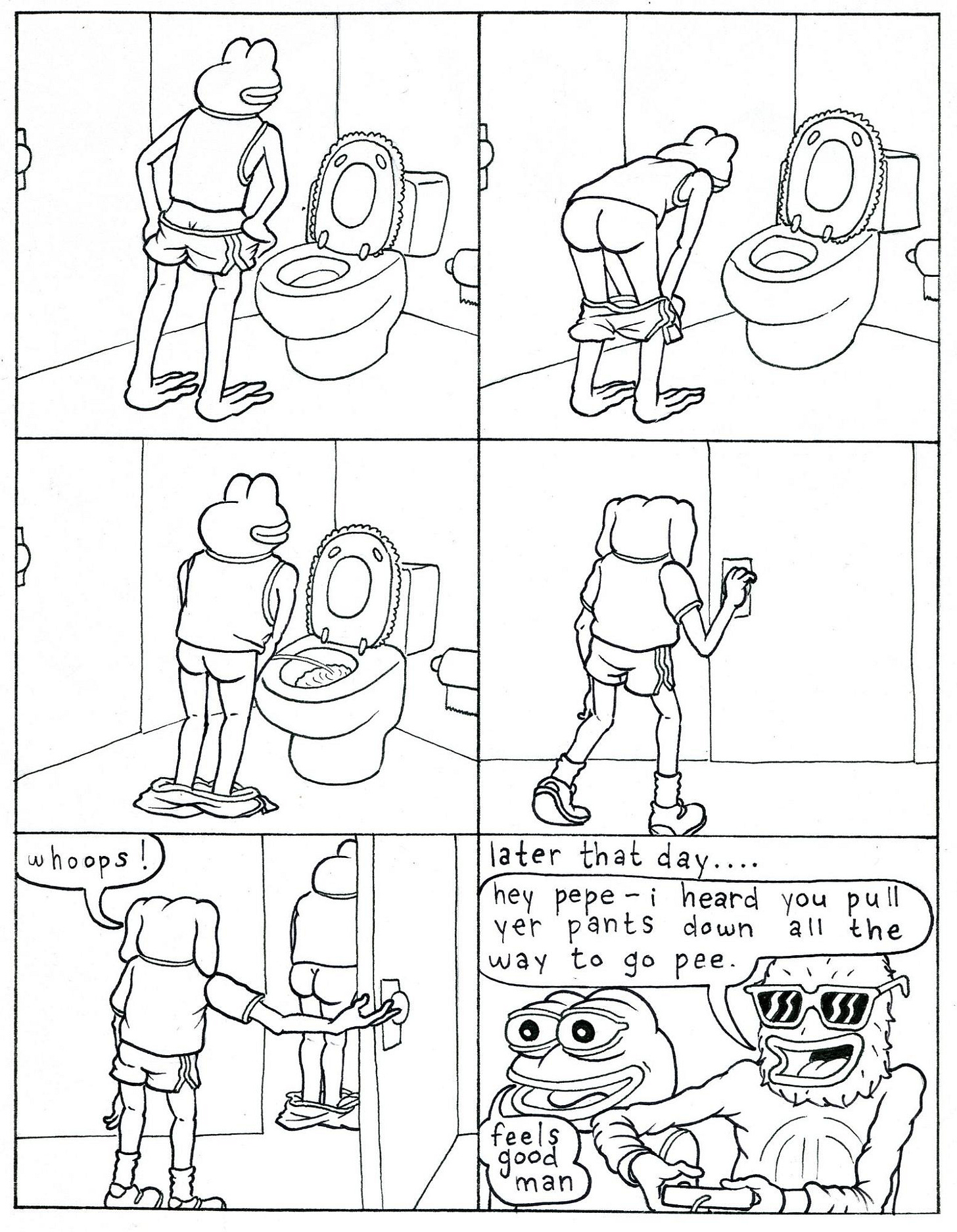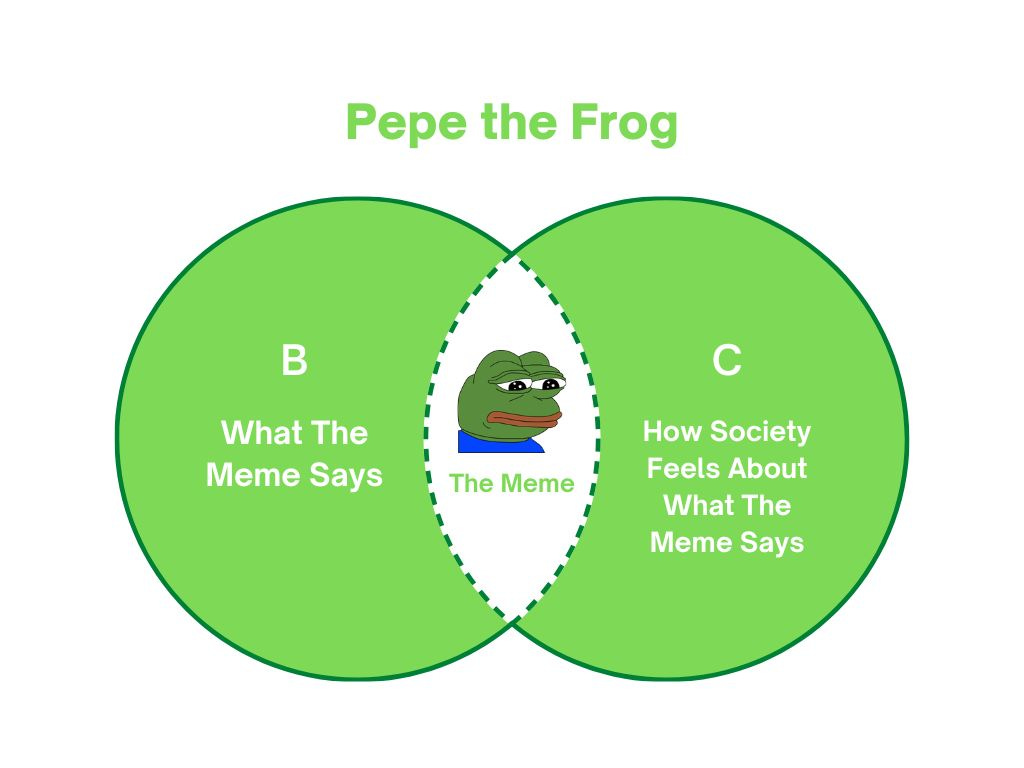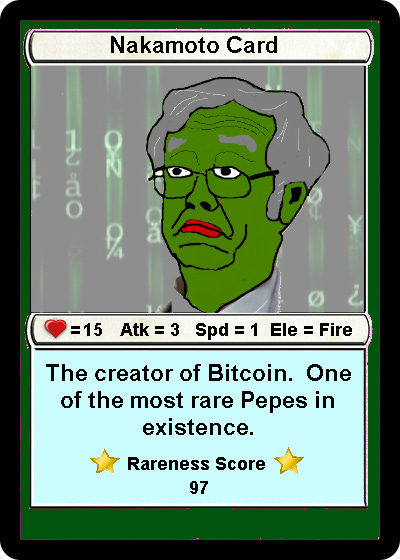🏆 The most important NFT ever
Why the Rare Pepe Nakamoto Card is the most significant NFT ever created (Part I)
Welcome to the first issue of Deep Dives with Mr. Fox, a new newsletter from The Metaversalist. In each issue, digital art collector, enthusiast, and researcher Mr. Fox will unpack, explain, and scrutinize a critical project, event, trend, or topic in the NFT space.
Whether you want to broaden your knowledge of the space, refresh yourself on a particular project, or plan your next play by deepening your understanding of how we got here, Deep Dives is here to help.
Right, let’s get straight into it!
It is our firm belief that, in the world of digital, tokenized assets, the Rare Pepe ecosystem is one of, if not the most important, NFT collection. And “The Nakamoto” is its crown jewel.
You’re welcome to disagree, of course. Given Pepe’s checkered history — from innocent character to symbol of extremism and hate, and from niche meme to become a milestone in crypto-art history — you might. But that means you’re the exact person we want to be reading this piece. Join us as we guide you down this magnificent rabbit hole of memetic historicity. Let’s begin.
Table of contents1
Matt Furie And The Birth of Pepe the Frog
Pepe’s Rise, Pepe’s Fall, and Pepe’s Comeback
The Rare Pepe Scientists, The Nakamoto, and the birth of CryptoArt and Rare Pepes
Pepe Persists, The Story of Fake Rares
Why Digital Assets Are Important
Why The Nakamoto is The Most Important NFT
Why The Nakamoto is an attractive investment
Accessibility, Friction, and Third-party risk
1. Matt Furie And The Birth Of Pepe The Frog
Pepe the Frog’s creator, Matt Furie, is a traditional artist and writer from Colombus, Ohio. There isn’t much out there in the way of information on Furie’s career or upbringing. In part, it feels like a Dr. Frankenstein situation: his reputation lives in the shadow of his creation.
Despite his creation having a rich history in Web3, it’s only in the last two years that Furie himself has made official forays into the space with both Pepe and non-Pepe-related pieces. Below are some examples of his work. Interestingly, his style isn’t unlike the child-like psychedelic-tinged work we see from major crypto artists like Killer Acid, and to some extent, Gremplin.

Contrary to what you might’ve assumed, Pepe the Frog was far from Furie’s life’s work when he first appeared. In fact, he was simply one of four main characters in a comic book called Boy’s Club.
Featuring the characters Landwolf, Andy, Brett, and Pepe, Boy’s Club was a comic detailing the misadventures and peculiar stories of this group of friends. Boy’s Club is incredibly degenerate, nihilistic, and at times even borderline sadistic. This may well be why Pepe has proliferated and come to represent a particular corner of the zeitgeist that shares those inclinations.
Many of the strips in Boy’s Club revolve around the rejection of the status quo, in both content and form. Wearing profane T-shirts and throwing up all over the house are routine for characters in this world. Further, Furie rarely feels the need to write a punch-line, often letting the absurdity of Boy’s Club do all the talking.
So, how and why did this style ignite Pepe’s initial popularity?
It’s these types of nihilistic cultural undertones that Millenials and Gen-Z will tell you they live and see every day. Their constant connection to the internet has left them desensitized to the gravity of the real world. We’re no longer surprised by their inability to take serious events seriously.
Likely Furie’s most remarkable stroke of genius — and the reason Pepe is where he is today — is how early he was able to sense the degenerate, nihilistic, and sadistic direction pop culture was headed for. Not only this, but his ability to produce art in line with these trends in a way that was emotive to many would be why Pepe would go on to become so popular.
But not in his wildest dreams could Furie have imagined that Pepe would be as recognized as he is today.
This was the six-frame strip that started it all:
Pepe pulling his pants down to his ankles to pee, Andy walking in on him, and Pepe’s response to Landwolf would combine to birth the most potent, most identifiable, and most important meme of all time.
“Feels good man.”
Furie put the strip (along with others from Boy’s Club) on his MySpace page, and it was quickly picked up and spread on other forum-based platforms at the time, like 4chan. Internet users began using Pepe as a means of communicating in ways that he wasn’t initially created for. Or, in other words, as a meme. Perhaps it was Pepe’s rejection of the status quo that struck a chord in particular with the 4chan community.
Pepe was likely, at least in part, the benefactor of some “right time, right place” good fortune — the internet had become self-referential and GIFs and memes were taking off and becoming not only shorthand for sub-cultures but a way of communicating across them. Why some memes rise to dominance is hard to pinpoint, but Pepe’s journey through and as a conduit of the culture had started.
2. Pepe’s Rise, Pepe’s Fall, And Pepe’s Comeback
In hindsight, Pepe’s meteoric rise was an early example of virality — his image literally spread like a virus, and eventually turned into a digital pandemic. Once he was released into the wild, his image would go from being seen by a handful of people to being seen by almost everyone with an internet connection.
It was the online bodybuilder community that first began using Pepe as a meme. Initially, they shared the “Feels good man” meme to celebrate new personal weightlifting records. Pepe’s use by these users was harmless. But soon thereafter, we’d see the first more nefarious variations of Pepe emerge.
Said variations would be seen and created by the 4chan community, where the use of “Feels bad man” or “Sad Pepe”' quickly became just as popular as the original meme.
What makes memes such productive cultural drivers is that they’re self-reflexive. As a meme is used, its commentary changes in real time, and in this sense, a meme is not simply about what it says, but is an endless combination of both what it says and how society feels about what’s being said. As the latter changes, so does the former, and as the former changes, so does the latter. The meme in question continually evolves to reflect the current feelings of the culture it represents.
It was this feedback loop that would take Pepe to the most sinister corners of 4chan. 4chan was a forum-based discussion site that attracted loners, incels, trolls, and other anti-social and very-online people, and the sorts of viewpoints likely to get someone banned on services like Reddit, Twitter, and Facebook. Pepe and the meme’s variations became the champion of a, more often than not, depressed and depraved group of internet users.
But the virality of Pepe created by Furie that existed in the very fabric of the frog continued to persist. Initially, despite 4chan users’ embrace of Pepe memes, they continued to proliferate on other platforms. Famously, both Katy Perry and Nicki Minaj used Pepe in social media posts of their own. The Pepe the Frog that started as the innocent Boy’s Club character had become nearly unrecognizable.
At this point, we were witness to another social phenomenon that came as a result of Pepe’s use. People struggle to let go of things that are precious or exclusive to them. It’s why parents have difficulty sending their children away for college, or why founders struggle to move on from their companies. 4chan users hated that Pepe — who they viewed as their emotional representative — was being used by others.
It was 4chan’s meme and its meme only, so users went on the offensive and turned Pepe into a symbol of hate to deter mainstream use. Users began creating versions of Pepe that were socially destructive and increasingly debased. Pepe began to appear in racist, pornographic, and supremacist memes at such volume that those became the association many people had with the icon.
Things would get worse for Pepe the Frog before they would get better. In October 2015, then-presidential candidate Donald Trump would post a version of himself as Pepe.
This was all the confirmation 4chan and alt-right groups needed to amplify their use of Pepe as a symbol of right-wing extremism and hate. In 2016, a video of someone shouting “PEPE!” at a Hillary Clinton campaign speech went viral. Clinton posted an opinion piece about Pepe the Frog and its use by Donald Trump and white nationalists that divided public opinion… but it inevitably egged on extremists.
White nationalist Richard Spencer would go on to use Pepe in his speeches, and InfoWars founder Alex Jones would reference Pepe on-air on multiple occasions. It’s little wonder than that the Anti-Defamation League (ADL) soon listed Pepe the Frog as an official hate symbol.
In late 2016, in an effort to reclaim and rehabilitate his creation, Furie (in collaboration with the ADL) started the #SavePepe campaign. The goal: take Pepe back from the hateful groups exploiting him and restore him to his youthful and innocent beginnings.
The efforts didn’t last for long, though. Donald Trump would win the 2016 U.S. presidential election, further solidifying the notion that Pepe was a right-wing extremist symbol.
In the spring of 2017, faced with an insurmountable battle against extremism, Furie was forced to move on from Pepe, and published a strip of the frog’s funeral, literally killing his most successful darling. Landwolf, Brett, and Andy, the characters from Pepe’s original debut in Boy’s Club, bore witness.
Although Pepe would be used two to three years later as a symbol of peace in Hong Kong’s protests against Chinese oppression, the meme’s mainstream lore was broadly finished. A documentary titled Feels Good Man would come out the same year as Trump’s presidential campaign loss, journeying through the turbulent life of Pepe the Frog. With Trump out of power and the novelty of Pepe wearing off, the foundations were set for Pepe’s slow comeback into the mainstream. But more on this later…
3. The Rare Pepe Scientists, The Nakamoto, And The Birth Of Rare Pepes And Cryptoart
While Pepe kept making headlines for controversial reasons, a subset of people unbothered (or perhaps intently unaware) of Pepe’s mainstream use had other ideas. They were known as the Rare Pepe Scientists, and they were creating their own versions of Pepe and putting them on the blockchain.
The Rare Pepe Scientists were uniquely passionate about the amphibian icon. They saw Pepe in an entirely light. In their eyes, Pepe couldn’t be claimed by any one group. Instead, Pepe could be whatever he was used for. If Pepe was to represent extremist groups, it’s because they used him in their aesthetic arsenal. But if Pepe was to be a mascot for cypherpunks, financial freedom, and a dose of degeneracy, this too was possible.
The Rare Pepe Scientists completely disregarded the negative uses of one of the world’s biggest icons and instead created a meaningful identity for Pepe the Frog despite his sordid history. This defiance would breathe life anew into Pepe years into the future when many thought him irrevocably tainted.
The Scientists designed and curated what would come to be known as Rare Pepe cards. Predominantly led by a man who simply goes by “Mike,” the team included Joe Looney, John Villar, Shawn Leary, Theo Goodman, and J-Dog. Together, they not only illustrated cards of their own but also picked from community submissions, resulting in the collection of early NFTs that would collectively become known as the Rare Pepes.
RAREPEPE, nicknamed “The Nakamoto,” was the first of all Rare Pepe cards put on the Bitcoin network. It is widely considered as the work that marks the birth of CryptoArt as we know it, which is one of the reasons Metaversal has one in its collection — there are few digital collectibles as iconic or historically relevant.
Although not the first NFT in history, nor the first NFT collection ever, the Rare Pepe Blockchain Project was the first instance of tokenized art. The Nakamoto — and Rare Pepes more broadly — represented the intersection of culture, digital asset experimentation, and the desire to squarely own internet art. It signaled a new paradigm, and crypto would never be the same again.
But The Nakamoto is just one of 1,774 different Rare Pepe cards. The richness of the cards as a group is truly magnificent, and it's a testament to the work the Rare Pepe Scientists put into curating a meaningful collection of culture.
In essence, each Rare Pepe takes inspiration from the evolving memetic nature of Pepe the Frog to become a meme in itself. The contents of an individual card can range from political commentary to crypto history to reimagined hip-hop cultural touchpoints. The point is that each Rare Pepe encapsulates a moment or feeling in time through memes.
Although there are 1,774 Rare Pepes, there is fragmentation among this group. They weren’t released into the world as a single batch. There are 36 “Series” of Rare Pepes, each with roughly 50 individual Rare Pepe Cards. Further, each card has its own supply.
The Nakamoto, for example, is the Series 1, Card 1, and it has a supply of 300. If you’re confused, frame it in television terms. You can think of the “Series” as seasons, the “Cards” in each Series as the episodes in the season, and the supply of a particular Card as the runtime of that episode.
Where Do Rare Pepes Live?
Rare Pepes are some of the only popular NFTs in the world to live on the Bitcoin network as opposed to Ethereum (or, more recently, Tezos and Solana). This simply shows how early and pioneering the Rare Pepe Blockchain Project was for its time.
How Does One Acquire A Rare Pepe?
Undoubtedly the most challenging aspect of Rare Pepes is the arduous process of acquiring one. As a result of existing on the Bitcoin blockchain, which doesn’t have smart contracts purposed for seamless transactions of other tokens created on the network, there are a lot of hoops to jump through.
There are several ways to go about acquiring a Rare Pepe, none of which are particularly easy, at least when compared to trading digital collectibles on Ethereum. Dispensers, a sort of blockchain vending machine, are frequently used to house available Rare Pepe cards, and require an “unlock” in the form of the amount of BTC required to buy the particular card.
Marketplaces like Scarce.city leverage Bitcoin-native protocols such as Counterparty to increase the ease of transacting on the proof-of-work blockchain. More recently, we’ve seen the proliferation of “Wrapped Pepes” — Rare Pepes given an Ethereum wrapper through a third party known as Emblem Vault, which allows for their transaction and storage in a way that closely resembles interaction with a standard Ethereum token.
We’re going to assess these railways of the Rare Pepe ecosystem, in particular their associated risks and benefits, as we discuss The Nakamoto from an investment perspective in the second half of this piece. Look out for it next week, and if you enjoyed this deep dive, please consider sharing it with someone else who might enjoy it too.
We’re indebted to the excellent resource wiki.pepe.wtf for much of the ground covered in the first four sections, and we encourage you to check it out for additional reading about Pepe’s past and legacy.















Great article but the people need to know if wrapped pepes are worth the investment!
Can't wait for part 2.
Thanks Mr. Fox!